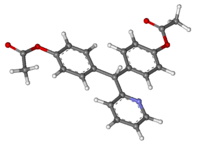Bisacodyl
 | |
 | |
| Clinical data | |
|---|---|
| AHFS/Drugs.com | Monograph |
| MedlinePlus | a601027 |
| Pregnancy category |
|
| Routes of administration | Oral, rectal |
| ATC code | A06AB02 (WHO) A06AG02 (WHO) |
| Legal status | |
| Legal status |
|
| Pharmacokinetic data | |
| Bioavailability | 15% |
| Metabolism | Hepatic (CYP450-mediated) |
| Biological half-life | 16 Hours |
| Excretion | primarily in the feces, systemically absorbed drug is excreted in the urine |
| Identifiers | |
| |
| CAS Number |
603-50-9 |
| PubChem (CID) | 2391 |
| DrugBank |
DB09020 |
| ChemSpider |
2299 |
| UNII |
10X0709Y6I |
| KEGG |
D00245 |
| ChEMBL |
CHEMBL942 |
| Chemical and physical data | |
| Formula | C22H19NO4 |
| Molar mass | 361.391 g/mol |
| 3D model (Jmol) | Interactive image |
| |
| |
| | |
Bisacodyl (INN) is an organic compound that is used as a laxative drug. It works directly on the colon to produce a bowel movement. It is typically prescribed for relief of constipation and for the management of neurogenic bowel dysfunction as well as part of bowel preparation before medical examinations, such as for a colonoscopy.[1]
Bisacodyl is a derivative of triphenylmethane. It was first used as a laxative in 1953 because of its structural similarity to phenolphthalein.[2][3]
Available forms
Bisacodyl is marketed under the trade names Dulcolax/Durolax, Fleet, Nourilax, Alophen, Correctol, and Carter's Little Pills (formerly Carter's Little Liver Pills[4]) as well as being available generically. It is usually sold as 5 mg tablets, 10 mg suppositories, or 5 mg pediatric suppositories. It is also available as a 1.25 US fluid ounces (37 ml) prepackaged enema containing a 10 mg delivered dose of liquid bisacodyl.[5]
Administration
When bisacodyl is administered orally, it is usually taken at bedtime. Oral administration is known to produce no action for more than eight hours and then to work suddenly and relatively quickly. This is especially true if more than 10 milligrams is taken at one time. Normally the dosage is 5 or 10 milligrams, but up to 30 milligrams can be taken for complete cleansing of the bowel before a procedure. If taken at the maximum dosage, there will likely be a sudden, extremely powerful, uncontrollable bowel movement and so precautions should be taken. It is not recommended to take bisacodyl within one hour of taking an antacid or milk, as this may destroy the tablet coating and irritate the stomach. If taken too early in the evening, the action of this drug can start during sleep with undesirable results.
When administered rectally in suppository form, it is usually effective in 15 to 60 minutes. Two suppositories can be inserted at once if a very strong, purgative, enema-like result is needed. A few hours after the initial evacuation, there can be a secondary action which will continue as long as there is unexpelled bisacodyl present in the rectum.
As a small commercially prepared enema, it is usually effective in 5 to 20 minutes.[5]
Mechanism of action
Bisacodyl works by stimulating enteric nerves to cause colonic contractions. It is also a contact laxative; it increases fluid and salt secretion. Action of bisacodyl on small intestine is negligible; stimulant laxatives mainly promote evacuation of the colon.[5]
See also
References
- ↑ Wexner, S. D.; Beck, D. E.; Baron, T. H.; Fanelli, R. D.; Hyman, N.; Shen, B.; Wasco, K. E.; American Society of Colon and Rectal Surgeons; American Society for Gastrointestinal Endoscopy; Society of American Gastrointestinal and Endoscopic Surgeons (2006). "A consensus document on bowel preparation before colonoscopy: prepared by a task force from the American Society of Colon and Rectal Surgeons (ASCRS), the American Society for Gastrointestinal Endoscopy (ASGE), and the Society of American Gastrointestinal and Endoscopic Surgeons (SAGES)". Gastrointestinal Endoscopy. 63 (7): 894–909. doi:10.1016/j.gie.2006.03.918. ISSN 0016-5107. PMID 16733101.
- ↑ Stiens SA; Luttrel W; Binard JE (November 1998). "Polyethylene glycol versus vegetable oil based bisacodyl suppositories to initiate side-lying bowel care: a clinical trial in persons with spinal cord injury" (PDF). Spinal Cord. 36 (11): 777–81. doi:10.1038/sj.sc.3100702. PMID 9848486.
- ↑ Evans, I. Lynn, "Methods and techniques: The use of Bisacodyl suppositories in preparation for sigmoidoscopy", Gut, British Medical Journal, 1964, 5, 271
- ↑ "Medicine: Cut Out the Liver". Time. 1951-04-16. Retrieved 2010-04-26.
- 1 2 3 Robert Engelhorn, Ernst Seeger and Jan H. Zwaving "Laxatives" in Ullmann's Encyclopedia of Industrial Chemistry, Wiley-VCH, Weinheim, 2000. doi:10.1002/14356007.a15_183